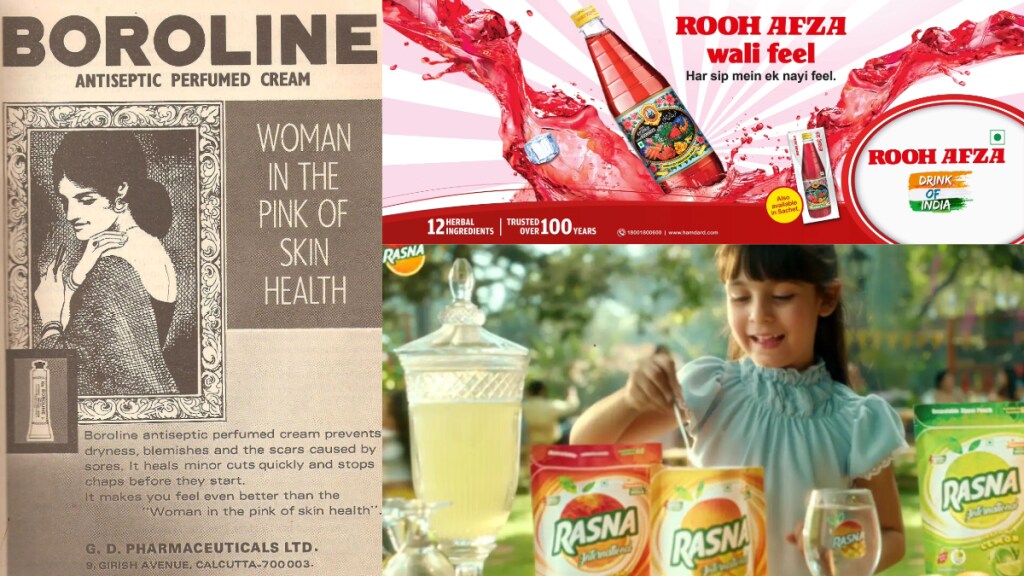Ahead of the peak summer season, soft drink concentrate brand Rasna announced Tamannaah Bhatia as its new ambassador to slide back into the consideration set. Though Rasna continues to account for over 80% of the $2.5-billion pre-mix soft drink market, it faces stiff competition from larger brands that offer equal convenience and have deeper pockets.
The challenge that Rasna faces is not unique. Iconic Indian brands, such as Gold Spot, Ambassador, HMT Wat-ches and Forhan’s toothpaste, fell by the wayside because they didn’t feel the need to respond to market shifts. There are others such as Vicco, Boroline, MDH, Dalda and Rooh Afza that continue to stand the test of time without massive brand makeovers or high decibel campaigns.
While older brands will continue to face the threat of new-age, agile brands, legacy remains a key component of their pick-up value. As Pranav Agarwal, co-founder, Sociowash, points out: “A clear example is Mahindra. A legacy brand, it has created a completely new persona for itself that caters to younger audiences and it has worked wonders. The brand’s sales numbers (the number 4 passenger car brand in terms of market share) are testament to that strategy.”
But is that slow and steady strategy good enough? How long can legacy brands endure with little or no effort to change? For failure to change can shake the foundation of the strongest of brands — remember how Facebook burst into the scene with its music-plus plan and better interface and pulled the rug from under the feet of MySpace?
N Chandramouli, CEO at brand insights agency TRA Research, says that survival is often linked to a category, the nature of the product and its impact on consumer buying intention. “While many believe nostalgia is key, brand growth is more a factor of habit,” says Chandramouli.
Many consumers of the current generation would have seen certain brands being used over generations. It could be a detergent or a popular tea-time biscuit. According to Nisheeth Srivastava, executive creative director, BBH India, these brands have formed permanent memory structures that translate into muscle memory when it comes to picking them off the shelf. “These create a flywheel effect, which is pretty much a self-fuelling machine and does not need the steroid of money. Also, making drastic changes to such brands’ identities may not serve them well because it will be like pulling out a Jenga block from the memory structure making it unstable,” remarks Srivastava, adding that subtle changes over some time might still work.
Formula for success
A key challenge is that older brands have to walk the tightrope between staying true to their core values while also making themselves relevant to younger consumers. Considering that over 65% of the Indian population is under 44 years of age, brands cannot afford to ignore the Millennial and GenZ demographic.
Ankit Banga, CBO at FCB/SIX India, says Gen Z and millennials are quick to switch between products and services, always eager to explore new options. In many industries, significant shifts are driven by this demographic. For instance, in entertainment, OTT platforms like Netflix have transformed how people consume content. “We have seen other brands like Nokia, Blackberry, Orkut, Yahoo and others that lost market share for not re-inventing on time,” he adds.
Ajimon Francis, MD India for Brand Finance and a former brand manager for Rasna, recalls that one substantial focus area for the brand has been in-store visibility, something that larger corporations such as HUL and Mondelez also focus on. He emphasises that heavy advertising campaigns alone do not build brands. Rather, it is the core product offering and consistency in customer experiences that drive long-term brand value.
“We have also seen that these brands have stayed relevant by innovating on packaging, or with small variants of their core products – like Rasna Insta and Vicco Facewash. Customers tend to pardon brands’ mistakes if they see that the core offering is not changing but that the brand is experimenting with new ones,” notes Francis. For example, Boroline launched its antiseptic skin lotion Suthol after seven decades of existence. Suthol today contributes almost 20% of its revenue with little in terms of advertising spend.
Chandramouli of TRA Research adds that distribution muscle is another important differentiator not just for legacy brands but also for younger ones. “Jo dikhta hai, woh bikta hai is the golden rule here and so distribution muscle is critical irrespective of how old or young the brand is,” he sums up.
Keeping it real
What works for hoary brands
Brand trust and familiarity
Strong local affinity
Nostalgia and emotional connections
Challenges before legacy brands
Staying relevant to GenZ and millennial consumers
Competition from MNCs and new-age D2C brands
Lack of evolution in product range
Source: Brand experts


